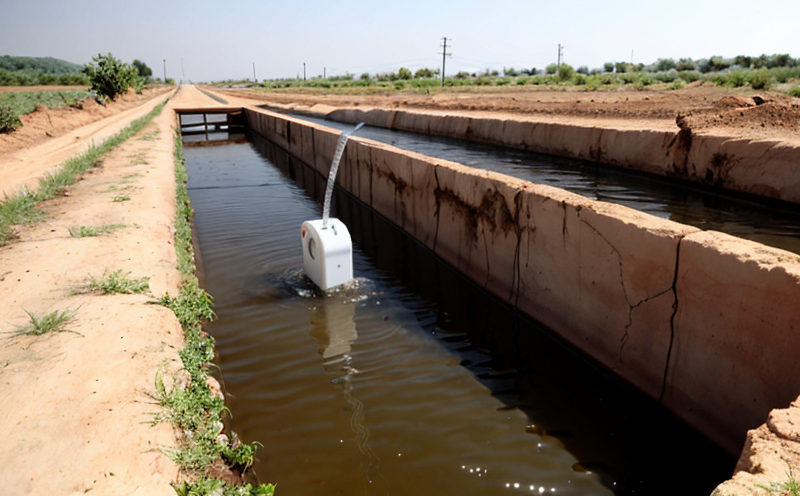ISO 10304 Ion Chromatography Anions in Water Testing
The ISO 10304 method for ion chromatography is a standardized procedure that enables accurate and precise determination of anions in water samples. This technique is widely used across various sectors, including mining, to ensure the quality of mine waters and groundwater, which are critical components in the operations of underground mines.
The primary objective of this testing procedure is to measure the concentration of specific anions such as chloride, nitrate, sulfate, fluoride, bromide, and other trace elements that can impact water quality. The method involves a series of steps: sample collection, filtration, conditioning, injection into the chromatography system, and detection using a conductivity detector.
The process begins with the collection of representative samples from various points within the mine or its surroundings. Samples are then filtered to remove particulate matter before being conditioned to match the mobile phase composition used in the ion chromatograph. The sample is injected into the column where it separates based on ion size and charge, allowing for accurate quantification.
The use of this method ensures compliance with international standards such as ISO 10304:2015, which sets out detailed procedures and acceptance criteria. Compliance officers responsible for environmental regulations can rely on these tests to ensure that mine waters meet the required quality levels. For R&D engineers, this test is essential in understanding how different chemicals interact within the water system and how they might affect mining operations.
The accuracy and precision of ion chromatography make it an indispensable tool for monitoring changes in water quality over time. This can be particularly useful in assessing the impact of mining activities on local ecosystems or during reclamation efforts post-mining cessation. In addition, this testing method helps maintain operational safety by detecting potentially harmful substances early.
Compliance with international standards like ISO 10304 also supports better decision-making processes within organizations regarding their environmental policies and practices. By adhering to these guidelines, companies demonstrate their commitment to sustainable development principles which are increasingly important in today’s regulatory environment.
Why Choose This Test
Selecting the ISO 10304 ion chromatography anions in water testing service offers several advantages over other methods. Firstly, its high sensitivity allows for precise quantification even at very low concentrations of target analytes. Secondly, it provides reliable results that are repeatable and reproducible, enhancing confidence in analytical outcomes.
Another key benefit is the ability to analyze multiple anions simultaneously without interference from cations or other components present in complex matrices like mine waters. This comprehensive approach ensures a thorough assessment of water quality parameters relevant to mining operations.
The test procedure follows strict protocols outlined by ISO 10304, ensuring consistency across different laboratories conducting similar analyses. Compliance officers can therefore rely on these results for making informed decisions about regulatory compliance and operational adjustments needed to maintain environmental standards.
For R&D engineers, this service provides valuable data that contributes to ongoing research projects aimed at improving water treatment technologies or developing new approaches for managing hazardous waste materials generated during mining processes.
Competitive Advantage and Market Impact
- Accurate Measurement: The ISO 10304 method offers unparalleled accuracy in measuring anions, providing reliable data that supports informed decision-making.
- Compliance Assurance: By adhering to international standards, companies demonstrate their commitment to environmental stewardship and regulatory compliance.
- Consistent Results: Strict protocol adherence ensures consistent results across multiple analyses conducted by different laboratories.
- Comprehensive Analysis: Simultaneous measurement of various anions in complex matrix samples enhances comprehensive understanding of water quality issues.
The use of this testing method can give mining companies a competitive edge by enabling them to identify and address potential environmental risks early on. This proactive approach not only helps maintain good standing with regulatory bodies but also promotes responsible corporate citizenship, fostering trust among stakeholders including local communities and investors.
Moreover, the ability to provide consistent, accurate data contributes significantly towards enhancing reputation management efforts within the industry. As sustainability becomes an increasingly important factor in business operations, having robust quality assurance measures in place is crucial for remaining competitive in both national and international markets.
Use Cases and Application Examples
In mining operations, ISO 10304 ion chromatography anions in water testing plays a vital role in ensuring the safety of workers and preserving environmental integrity. One common application is monitoring drinking water supplies used by miners during their shifts.
Detection of harmful concentrations of chloride or nitrate can indicate potential leaks from mine waste rock piles or tailings dams, necessitating immediate corrective action to prevent contamination spread. Another critical use case involves assessing the quality of wastewater discharged into nearby rivers and streams.
By identifying excessive levels of sulfate or fluoride, companies can implement strategies aimed at reducing these emissions through improved filtration systems or alternative disposal methods. Additionally, this testing method is instrumental in evaluating groundwaters surrounding mine sites for compliance with local regulations concerning acceptable pollutant thresholds.
The results obtained from ISO 10304 tests serve as valuable input into long-term planning activities related to environmental restoration projects following closure of mines. Understanding baseline conditions prior to reclamation efforts allows for targeted interventions designed specifically to address identified deficiencies while promoting sustainable practices throughout the lifecycle of mining operations.





